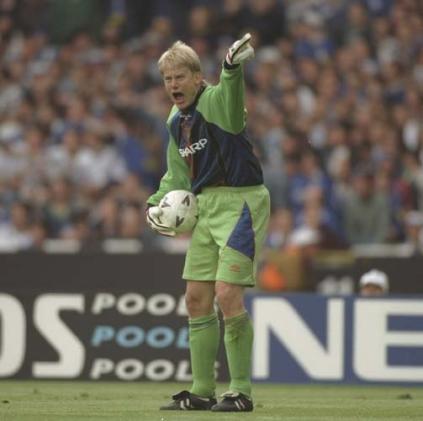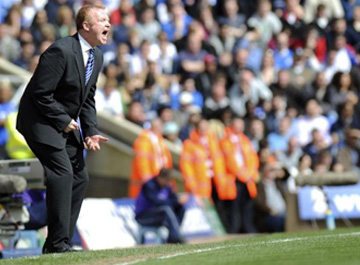-
Recent Articles
The Midfielder as Centerback
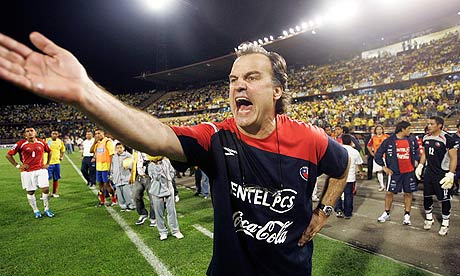 Marcelo Biesla and Josep Guardiola are both managers who play a very high line with their respective sides and who both demand that all players be technically proficient with the ball. Part of playing...
Marcelo Biesla and Josep Guardiola are both managers who play a very high line with their respective sides and who both demand that all players be technically proficient with the ball. Part of playing...Understanding the 4-4-2 Diamond
DEFENCE Despite the fact that there are four ways to play a diamond formation on FM, the differences between them are few and usually subtle. As a starting point, one thing each of them do have...3 at the back and the 4-4-2 Diamond
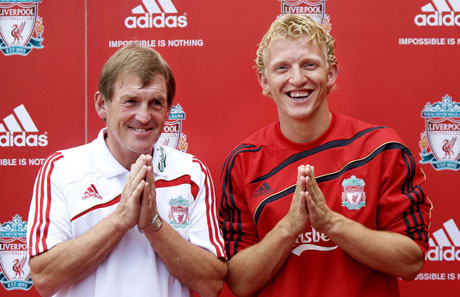 Last week Chelsea v Liverpool became the biggest tactical talking point of the season. Liverpool revived the the 3 man defence that Kenny debuted against Stoke. While with the introduction of Torres for £50m...
Last week Chelsea v Liverpool became the biggest tactical talking point of the season. Liverpool revived the the 3 man defence that Kenny debuted against Stoke. While with the introduction of Torres for £50m...How To Set Up A Back Four
 Last year, I wrote a guide about how to play a simple 4-4-2. One of the major components of that is the back four. In fact, most modern formations build upon four defenders; two full backs and two centre...
Last year, I wrote a guide about how to play a simple 4-4-2. One of the major components of that is the back four. In fact, most modern formations build upon four defenders; two full backs and two centre...Building Your Defence: Full Backs
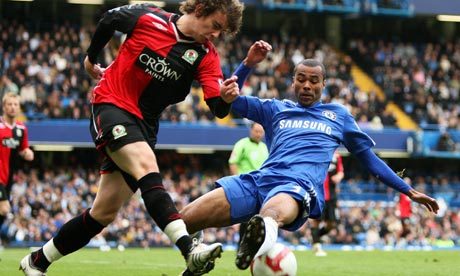 The modern full back is quickly becoming one of the most important players on the team sheet, infact even back in the days of Brian Clough, fat ed' argued that because of the space these players get in the final...
The modern full back is quickly becoming one of the most important players on the team sheet, infact even back in the days of Brian Clough, fat ed' argued that because of the space these players get in the final...
JOIN 12,748 READERS - SUBSCRIBE NOW TO OUR FOOTBALL MANAGER NEWSLETTER
Get the latest FM news & best community content delivered directly to your e-mail inbox!
The Lazio 3-5-2/5-2-3 Sweeper
Written by: Mihail Vladimirov
Category: General
Posted on: June 14, 2010
June 14, 2010
Mihail takes a look at re-creating the Lazio 3-5-2 shape within Football Manager an interesting look at how to create a system that moves from defence to attack quickly and how the players reposition themselves in each phase.
The first place to start with any tactical decision building is what football you want to play and the aims of the tactics. I am looking to recreate the Lazio 2009/10 tactic and the way it moves from defence to attack quickly, the aims of the tactical setup will be;
- Good shape and tactical discipline with a rigid philosophy
- Control the play and possession patiently waiting for opportunities to attack.
- Each player will have a particular role in the build up of play and will look not to deviate.
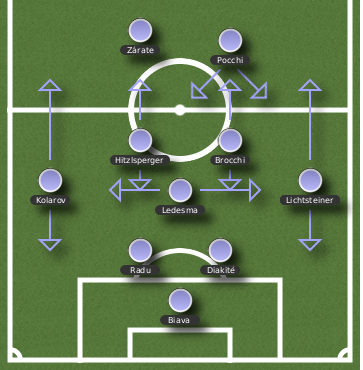
Roles and duties
Defenders
Muslera will act as a traditional goalkeeper as the team will play with a sweeper in front of him already, therefore not needing to deal with the space behind the defensive line.
That sweeper will be the experienced Biava, who has tactical intelligence and possess decent amounts of pace and mobility to roam behind the defensive line sweeping up potential dangerous balls and opposition players. Both of them is good at marking and in the ability in the air, he is a well rounded player.
Intelligent and pacey Rabu will partner Diakite a more physical presence and dominate in the air. Both of them will be instructed as limited defenders, with the aim to just stop the oppositions attacks and put the ball way out of trouble, or feed the midfielders around them.
The wide defenders will be Kolarov on the left and Lichstneiner on the right. They will act as attacking wing-backs aiming to roam between the two penalty areas, giving width to the team’s attack and penetration through the flanks. Good on the ball and able to dribble to before crossing the ball. Intelligence to know when and where to move off the ball will prevent the team being short at the back. Great stamina will be needed to get the players back and forth on the wing for 90 minutes.
Midfield
Ledesma, the deep-lying player in our midfielder will be the main playmaker of the team, acting as a link between play. When defending this player will act as an anchor man relying on his anticipation and positioning, rather than on pressing and harsh tackles, while in attack he will step into the opposition half, to control play, distributing killer balls and feeding the attacking players. His first aim is to receive the ball from deep, then distribute it to the flanks or trying to start counter-attacks with direct passes to the two forwards. Ledesma’s vision and intelligence vital in helping him pick out the right passes.
The central midfield will have a defensive duty to press and destroy the oppositions attacks early in their half, while in attack to join from deep supporting the main playmaker to build-up the team’s attacks. First-choice players will be Hitzlsperger and Brocchi. The German player has great vision and passing ability, which will be a great help to the playmaker and dangerous from long-shots. Brocchi is typical pressing player, aggressive and physical he will help the team to disrupt the opposition attacks. Both of them will be supporting ball-winning players.
When the team is in need of more offensive input in this zone, Brocchi can be replaced with Mauri, who is more adept with attacking able to get into opposition area and score goals. Dabo, who a more natural defensive midfielder and will help the team become more defensive.
Forwards
In attack Zarate and Rocchi both players will have the freedom to move around as complete forwards. Given the fact that Zarate is the faster player he will spearhead the team’s attack. Rocchi is the far more combination player, good teamworking to play in slightly deeper position supporting Zarate. Cruz with vision and passing ability for a striker can give different option to Rocchi. A more physical presence he can act as a target man, his ability to hold up the ball can help bring other players into the attack and feed Zarate by nodding the ball down to him in quick direct attacks.
Behaviour in defence phase
The positive thing is that the team will outnumber the opposition attacks in our half. The two wing-backs and the two central defenders will form a flat back-four, which will be shielded by the main playmaker and the two central midfielders, also will be guarded by the sweeper. The wing-backs will help out the two central midfielders when any attacks are coming through the wings or will help the central defenders. The two forwards will always offer passing destination and attacking treat of counter-attack, roaming around the centre of the pitch.
Such behaviour can be seen in the match against Inter, where the opposition was neutralised in full through the whole match.
Behaviour in attack phase
Given the fact that the team have at least one player in almost every zone of the pitch (exclude the ML/R,AML/R and AMC strata ) the transition between the two phases will be fluid and easy, with no need to leave huge empty space in our half – because when the wing-backs go forward the two central defenders will move into wider position, covering the flanks, while the sweeper will stay central.
The wing-backs will be given the most freedom on the pitch, they will be the players that will be free to receive the ball and start the team’s attacks. Given the fact that the main playmaker is playing in a deep position, he will have the opportunity to receive the ball in deeper positions and the time and space to control the ball and decide where, when and how to pass the ball, starting the team’s attacks. He will have four potential direct passing outlets – two wing-backs and the two forwards, to start quick counter attack. When these passing outlets are not available then he will have the opportunity to pass a short, keeping possession and pass to his team-mates in the centre of the pitch, starting a patient and possession-based attack, which will give the main four attacking player time to move in more “clear” attacking positions.
When the team is approaching a slow and patient attack with more short passes the whole team will have time to move from one phase to the other. The benefit of this approach is that the two central midfielders can get into more advanced positions, acting as pure attacking midfielder, getting into the spaces that were left free by the constant movement of the two forwards. Doing this our team will have enough players to attack, leaving the opposition outnumber, in their own half. While the two central defenders and the sweeper will always be in position to prevent any counter attacking.
Our game against Young Boys demonstrated our attacking play brilliantly.
After laying out the theoretical plan, the next article will analyse the positive and negative things of this system/tactical setup. Testing it against much more teams and different tactical systems.
Please feel free to pop into the forums and give me your feedback on the system.
About The Author: Mihail Vladimirov
From Bulgaria, you will find 'Cagiva' lingering around the FM-Britain forums waiting to help or discuss the tactical intricacies of football. As part of the Tactical Think Tank, he has helped on many projects including Tactical Theorems '10 and the TT10 Appendix.
Download Our Tactical Theorems '10 eBook Absolutely Free

Presenting the most comprehensive tactic design and match strategy guide to the Football Manager series ever created!
Written by FM match engine beta testers, it's 60+ pages of easy-to-read concepts and ideologies for getting your team playing exactly how you want each match! It's been downloaded over 100,000+ times to date!
Find out more information about our tactical eBook
and download Tactical Theorems '10 right now!
Written by FM match engine beta testers, it's 60+ pages of easy-to-read concepts and ideologies for getting your team playing exactly how you want each match! It's been downloaded over 100,000+ times to date!
and download Tactical Theorems '10 right now!


